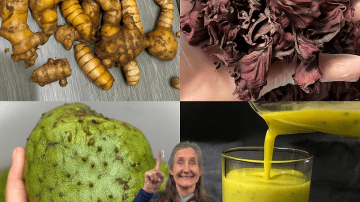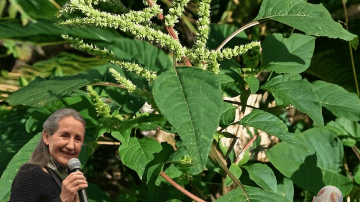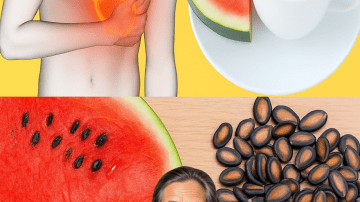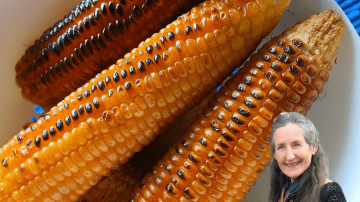Before you toss those banana peels into the trash, hold on! Those golden scraps are more than just kitchen waste—they’re a gardener’s secret weapon. Packed with nutrients like potassium, phosphorus, and calcium, banana peels can supercharge your garden, boost plant growth, and even fend off pests. If your household goes through a bunch of bananas each week, you’re sitting on a goldmine of free, eco-friendly gardening solutions. Curious about how to unlock their potential? Dive into these eight brilliant ways to recycle banana peels in your garden and watch your plants thrive like never before. Your garden (and the planet) will thank you!

🌱 Why Banana Peels Are a Gardener’s Dream
Banana peels are a powerhouse of nutrients that plants crave. They’re organic, cost-free, and easy to use, making them perfect for both outdoor gardens and indoor houseplants. From enriching soil to repelling pests, these versatile peels offer sustainable solutions that rival expensive fertilizers. Ready to give your plants a nutrient-packed treat? Here’s how to put those peels to work.
☕ 1. Brew Banana Peel Tea for Lush, Happy Plants
Your plants deserve a nourishing drink, and banana peel tea is just the ticket to boost their growth and vitality.
Why It Works
Banana peels release potassium and other minerals into water, creating a nutrient-rich “tea” that feeds your plants and promotes healthy development.
How to Do It
- Place one or two banana peels in a container of water.
- Let them steep for 48 hours to infuse the water with nutrients.
- Use the liquid to water your plants, giving them a direct dose of goodness.
What You’ll See
Your plants will perk up with vibrant leaves and stronger growth. This method is perfect for both garden beds and potted houseplants.
Pro Tip
Save the used peels for other hacks, like composting or burying them in the soil, to maximize their benefits.
🌍 2. Bury Peels for a Nutrient Boost in Your Garden
Turn your banana peels into a slow-release fertilizer by tucking them into the soil.
Why It Works
As peels decompose, they release essential nutrients like potassium and phosphorus, enriching the soil and supporting healthy root development.
How to Do It
- Chop fresh or used banana peels into small pieces.
- Bury them just below the soil surface or deeper near plant roots, ensuring they won’t interfere with seed growth.
- Water the area to kickstart decomposition.
What You’ll See
Your plants will thrive with stronger roots and lusher foliage, thanks to the steady nutrient release.
Pro Tip
Avoid placing whole peels too close to the surface to prevent attracting pests. Chopping them up speeds up decomposition.
♻️ 3. Create Nutrient-Rich Compost with Peels
If you’re passionate about reducing waste, banana peels are a fantastic addition to your compost pile.
Why It Works
Banana peels break down quickly, adding potassium, nitrogen, and other nutrients to create rich, fertile compost for your garden.
How to Do It
- Toss banana peels into your compost bin along with other organic waste like vegetable scraps or coffee grounds.
- Turn the compost regularly to ensure even decomposition.
- Use the finished compost to enrich garden beds or potting soil.
What You’ll See
Your compost will become a nutrient-dense powerhouse, giving your plants a healthy boost and reducing landfill waste.
Pro Tip
Balance your compost with “brown” materials like dried leaves to prevent it from becoming too wet or smelly.
🌾 4. Make a DIY Dry Fertilizer Powder
Transform banana peels into a versatile, shelf-stable fertilizer that’s ready to use whenever your plants need a pick-me-up.
Why It Works
Dried banana peels are packed with concentrated nutrients, making them an easy way to enrich soil before planting or during the growing season.
How to Do It
- Dry banana peels in the sun or an oven at low heat until crisp.
- Grind them into a fine powder using a blender or coffee grinder.
- Sprinkle the powder into soil or mix it into potting mix before planting.
What You’ll See
Your plants will enjoy a steady supply of nutrients, leading to stronger growth and more vibrant blooms.
Pro Tip
Store the powder in an airtight container to keep it fresh for months.
🌿 5. Plant Whole Peels for a Simple Nutrient Kick
For a no-fuss approach, bury whole banana peels to give your plants a direct nutrient infusion.
Why It Works
Whole peels decompose slowly, releasing nutrients over time to support root growth and overall plant health.
How to Do It
- Dig a trench about 10 cm deep near your plants.
- Place a whole banana peel in the trench and cover it with soil.
- Sow seeds or plant above the peel for a nutrient boost.
What You’ll See
Your plants will grow stronger and healthier, with the peels providing a natural, slow-release fertilizer.
Pro Tip
Use this method for new plantings to give seedlings a strong start.
💦 6. Whip Up a Nutrient-Packed Fertilizer Spray
Take your banana peel game to the next level with a sprayable fertilizer that delivers nutrients directly to your plants’ leaves and roots.
Why It Works
Combining banana peels with eggshells and Epsom salt creates a nutrient-rich spray that boosts potassium, calcium, and magnesium levels.
How to Do It
- Blend dried banana peels into a powder.
- Mix with ground eggshells and a pinch of Epsom salt.
- Add the mixture to water, stir well, and pour into a spray bottle.
- Lightly mist plant leaves or soil.
What You’ll See
Your plants will absorb nutrients quickly, resulting in greener leaves and more robust growth.
Pro Tip
Use this spray sparingly on houseplants to avoid over-fertilizing.
🐞 7. Set a Natural Insect Trap
Keep pesky insects at bay with a chemical-free trap made from banana peels.
Why It Works
The sweet aroma of banana peels, combined with apple cider vinegar, lures pests into a trap they can’t escape, protecting your garden naturally.
How to Do It
- Soak a banana peel in apple cider vinegar for a day.
- Place the mixture in a plastic container with small holes poked in the lid.
- Set the trap near affected plants.
What You’ll See
Fewer pests bothering your plants, creating a healthier garden without harmful chemicals.
Pro Tip
Check and empty the trap regularly to keep it effective.
🍇 8. Craft Banana Vinegar for Acid-Loving Plants
Give your acid-loving plants, like blueberries or azaleas, a treat with homemade banana peel vinegar.
Why It Works
Fermented banana peels create an acidic solution that lowers soil pH, perfect for plants that thrive in acidic conditions.
How to Do It
- Place banana peels in a jar of water and cover loosely.
- Let it ferment for 4–6 weeks, stirring occasionally.
- Strain the liquid and use it to water acid-loving plants.
What You’ll See
Your plants will flourish with improved soil conditions, leading to more vibrant blooms and healthier growth.
Pro Tip
Test your soil’s pH before using vinegar to ensure it’s suitable for your plants.
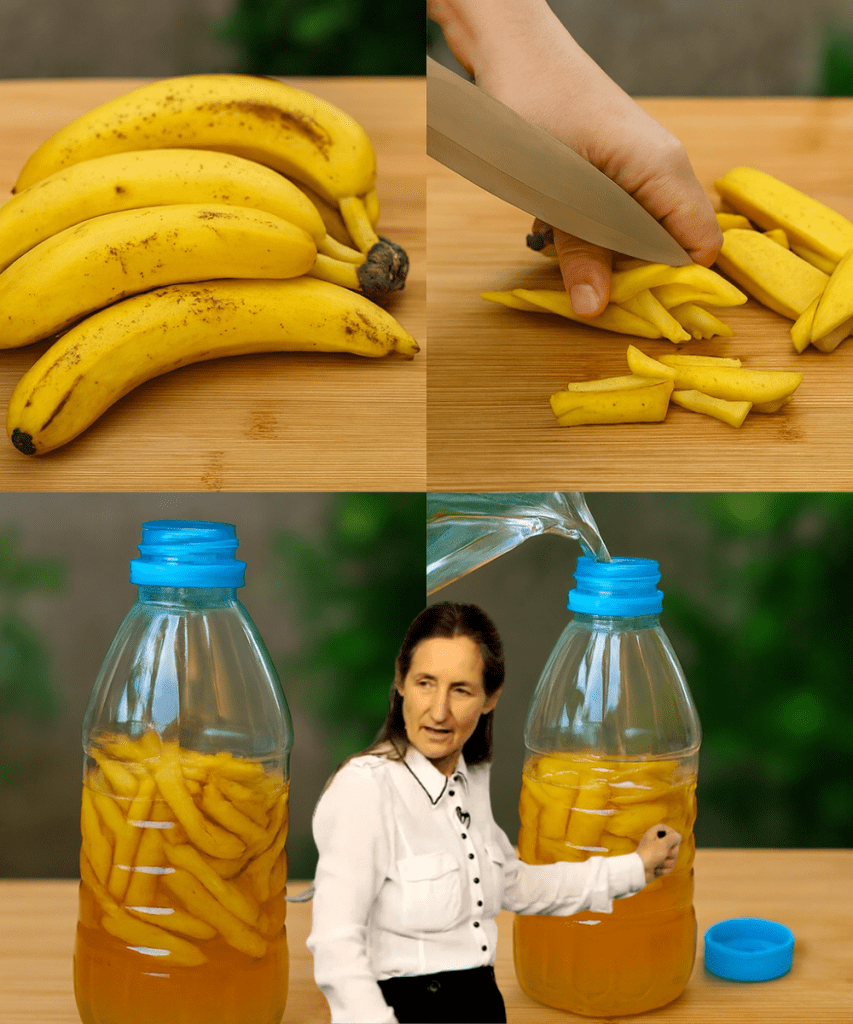
🌟 Beyond the Garden: Bonus Uses for Banana Peels
While banana peels shine in the garden, they’re also handy around the house. Rub the inside of a peel on your shoes for a natural shine, or use it to soothe skin irritations like bug bites or minor bruises. These extra uses make banana peels a true multitasking marvel.
🌎 Why You’ll Love Recycling Banana Peels
Recycling banana peels isn’t just good for your garden—it’s a win for the environment. By repurposing peels, you reduce food waste, save money on fertilizers, and create a sustainable gardening routine. Plus, these methods are simple enough for beginners and rewarding for seasoned gardeners alike.
Real Results from Real Gardeners
Gardeners rave about the difference banana peels make: “My roses have never looked better!” and “I’ve cut my fertilizer costs in half!” With minimal effort, you can achieve lush, thriving plants and a healthier garden ecosystem.
🚀 Ready to Revolutionize Your Garden?
Don’t let those banana peels go to waste! Whether you’re brewing tea, making compost, or setting pest traps, these eight hacks will transform your gardening game. Grab those peels, get creative, and watch your plants flourish like never before. Your garden deserves this nutrient-packed, eco-friendly boost—start today and see the magic unfold!


